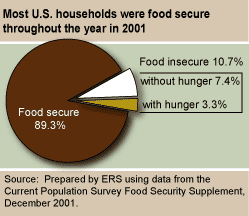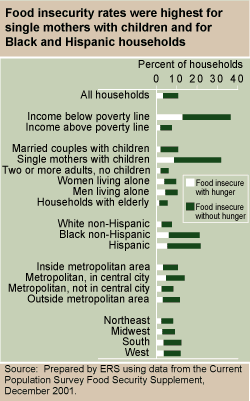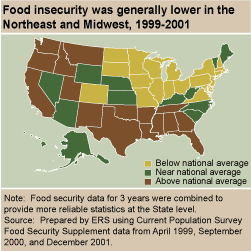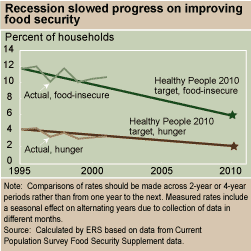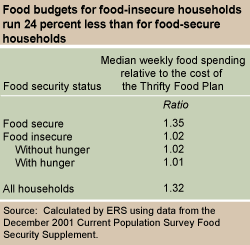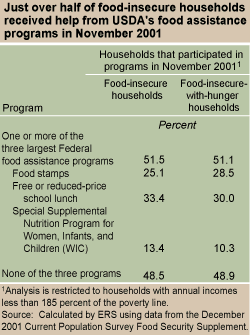Putting Food on the Table: Household Food Security in the United States
- by Mark Nord and Margaret Andrews
- 2/3/2003
Household food security—access at all times to enough food for active, healthy living—is taken for granted by most Americans. The struggle to avoid overeating is a more common American experience than the struggle to put enough food on the table. However, some American households do have difficulty at times getting enough food for all members.
An annual nationally representative food security survey, last conducted in December 2001, indicated that nearly 9 out of 10 U.S. households were food secure throughout the entire year. However, 11.5 million households (10.7 percent of all U.S. households) were food insecure at some time during the year. 'Food insecure' means that the household did not always have access to enough food for active, healthy living for all household members because they lacked money or other resources for food.
Most food-insecure households obtained enough food to avoid hunger, in some cases by relying on a few basic foods and reducing variety in their diets, participating in Federal food assistance programs, or getting emergency food from community food pantries. But in 3.5 million households (3.3 percent of all U.S. households), one or more household members were hungry, at least some time during the year, because they couldn't afford enough food. Hunger, as measured by this survey, refers only to involuntary hunger that results from not being able to afford enough food. Those hungry only because they were dieting to lose weight, fasting for religious reasons, or just too busy to eat were excluded from the count.
Children—especially younger children—were almost always shielded from hunger even in households where adults were sometimes hungry because they lacked money for food. Only 211,000 households (0.6 percent of households with children) reported food access problems so severe that any children in the household were hungry at any time during the year.
Only a small proportion of food-insecure households suffer food hardships frequently or chronically, although most do experience food insecurity as a recurring condition, not just as a single episode. Households in the food security survey are classified as food insecure even if they underwent just a single short spell of food insecurity during the year. As a result, annual rates of food insecurity and hunger are much higher than the incidence of these conditions on any given day. ERS research has estimated, for example, that the prevalence of hunger on a typical day is about 13-18 percent of the annual rate. So on a typical day in 2001, about 500,000 of the 108 million households in the Nation included a member who was hungry because the household could not afford enough food.
Data for these statistics come from a food security survey conducted annually for USDA by the U.S. Census Bureau. The survey asks a nationally representative sample of about 50,000 households how much they spend on food, whether they used various public food assistance programs, and whether their household was consistently able to get enough food to meet the needs of all household members. Households are classified as food secure, food insecure without hunger, or food insecure with hunger based on their responses to 18 questions about behaviors, experiences, and conditions known to characterize households that are having trouble meeting their food needs (see How Food Secure Is Your Household). Hunger among children is measured by a subset of the 18 questions that ask specifically about the conditions and experiences of children. The food security survey is a key component of the national nutrition monitoring system, a collaboration among several Federal agencies that measures and monitors food access, food intake, and the nutritional status of the U.S. population.
Food Security Is Linked to Income and Household Composition
Since food insecurity and hunger, as measured by USDA, must result from insufficient household resources, it follows that food security depends greatly on income. In 2001, food insecurity was five times more prevalent in households with annual incomes below the poverty line ($17,960 for a family of two adults and two children) than in households with incomes above that range. Even so, almost two-thirds of households with incomes below the poverty line managed to remain food secure throughout the year, while some households with annual incomes well above the poverty line were food insecure at times. This reflects, in part, the influence of other factors on food security: the stability of income and employment; local costs of food, housing, and other basic needs; receipt of food assistance and other noncash assistance; health of household members; ownership of assets; family stability; and household management skills.
Food security also depends considerably on household structure and composition. Food insecurity was least common among households consisting of two or more adults with no child present (6.0 percent) and households that included an elderly person (5.5 percent). Single mothers with children registered the highest rate of food insecurity (31.9 percent), while married couples with children (10.7 percent) were at the national average. These differences result in part from income differences associated with household composition, but even when the effects of income are accounted for, single mothers with children are more likely to be food insecure than married couples or single fathers with children, and households with elderly members are less likely to be food insecure than those without elderly. Rates of food insecurity were higher among Black and Hispanic households (21.3 percent and 21.8 percent) than among White non-Hispanic households (7.6 percent), reflecting primarily the lower incomes and higher poverty rates of these groups.
Food insecurity is somewhat concentrated geographically and in large urban centers. Households located in central cities and nonmetropolitan areas had higher rates of food insecurity than did households in suburbs and other metropolitan areas outside central cities. Food insecurity was more prevalent in the South and West than in the Northeast and Midwest.
Food Security Improved During the Economic Expansion of the Late 1990s
The U.S. Government has set a goal for the Nation—expressed in the Department of Health and Human Services' Healthy People 2010 objectives—of reducing the prevalence of food insecurity from 12 percent (as measured in 1995) to 6 percent or less by 2010. Initial progress toward this objective was encouraging. Between 1995 and 1999, food insecurity declined by 1.7 percentage points and the prevalence of hunger fell 1.2 percentage points. These improvements reached almost all regions and types of households, and were largest for some of the more food-insecure groups, especially single women with children and Black and Hispanic households.
As the economy entered a recession in 2001, however, food insecurity and hunger increased, slowing or reversing progress toward the Healthy People 2010 objectives. From 1999 to 2001, the prevalence of food insecurity rose by 0.6 percentage point and the prevalence of hunger rose by 0.3 percentage point.
Food-Insecure Households Spend Less on Food . . .
Food-insecure households spend less on food than food-secure households. To compare food spending across households of different sizes and age-gender mixes, ERS researchers express the amounts households reported they usually spent for food as ratios to the cost of USDA's Thrifty Food Plan, a national standard for a nutritious diet at low cost (see USDA's Thrifty Food Plan Quantifies a Low-Cost Diet). For example, the cost of the Thrifty Food Plan for a family consisting of two adults and two children ages 2 and 4 was $91.10 per week. In 2001, the typical (median) food-secure household of this type spent 35 percent more than this amount, or about $123 per week, while the typical food-insecure household spent just 2 percent more than the cost of the plan, or about $93 per week.
. . . And Are More Likely To Use Food Assistance
When households with limited resources are unable to buy enough food, they often turn to Federal food assistance programs or emergency food providers in their communities. About half of food-insecure households received assistance from one or more of the three largest Federal food assistance programs during the month prior to the December 2001 food security survey. The largest share of food-insecure households was reached by the National School Lunch Program (33.4 percent), followed by the Food Stamp Program (25.1 percent) and the Special Supplemental Nutrition Program for Women, Infants, and Children (WIC) (13.4 percent).
Community food assistance programs such as food pantries, emergency kitchens, and homeless shelters also tend to the food needs of low-income households. In 2001, some 3 million households (2.8 percent of all U.S. households) obtained food from food pantries at least once during the year. Most of these households used food pantries sporadically, although 20 percent reported using them in almost every month. Food-insecure households were 21 times more likely than food-secure households to have obtained food from a food pantry, and food-insecure households registering hunger were more than twice as likely to have used a food pantry as those that were food insecure without hunger.
But what of the large majority of food-insecure households, even those with hunger, that did not use a food pantry at any time during the previous year? In some cases, there was no food pantry available or the household did not know if one was available. Among food-insecure households that did not use a food pantry, 28 percent reported that there was no such resource in their community, and an additional 19 percent said they did not know if there was. Nevertheless, even among food-insecure households that knew there was a food pantry in their community, only 30 percent availed themselves of it.
Searching for the Connections: Causes and Consequences of Food Insecurity
Monitoring the incidence of food insecurity is only a beginning. Understanding its causes and consequences is also critical for assessing the threat that food insecurity poses to health and well-being and for improving policies and programs to reduce the prevalence and severity of food insecurity.
Much is already known about the root causes of food insecurity—low and unstable income, unemployment and unstable employment, disability, family disruption, and lack of community and extended family support—but much also remains unknown. To what extent do economic and food assistance programs buffer against food insecurity? Are there holes in the social safety net that leave people without enough food? If so, where? What barriers prevent food-insecure households from participating in programs that could reduce their food insecurity? How do government and community food programs work together, and where are they redundant?
Less is known about the consequences of food insecurity. Of course, most people consider food insecurity itself to be undesirable—at least at the more severe level of resource-constrained hunger—whether or not it leads to other problems. And it is known that food insecurity has deleterious effects on nutrition, health, weight, and children's psychosocial development and learning. But research into these relationships has, so far, established only their general outlines. Much work remains to assess the extent to which food insecurity affects these conditions, to explore other suspected consequences of food insecurity, to find out how the severity and duration of food insecurity affect its consequences, and to understand the mechanisms through which food insecurity leads to negative outcomes.
ERS supports data collection, conducts research, and funds studies by universities and private research organizations to further understanding of these issues. In addition to sponsoring the annual food security surveys in conjunction with the Census Bureau, ERS provides funding and technical support for several other Federal, State, and special population surveys that collect information on food security. Among these are major Federal surveys focusing on health, nutrition, education, child development, and welfare programs. The same food security measure described in this article—based on households' own reports of their food-related behaviors and conditions—is used consistently across all of these surveys, ensuring comparability and maximizing the potential for combining research results from multiple studies.
A healthy, well-nourished population is a national objective as well as a key resource for achieving other national objectives. Food security does not guarantee health and good nutrition, but it is difficult for families to prepare healthy, nutritious meals without consistent access to enough food. Food security monitoring and research are, therefore, important elements of the Nation's health and development strategies. The work of USDA and its partners in the food security measurement project-collecting food security data, assessing and refining food security measurement methods, monitoring food security, and investigating the causes and consequences of food security and food insecurity-informs the economic policies and the safety-net programs that promote the food security of all Americans.
This article is drawn from:
- Nord, M., Andrews, M. & Carlson, S. (2002). Household Food Security in the United States, 2001. U.S. Department of Agriculture, Economic Research Service. FANRR-29.
- Nord, M. & Andrews, M. (2002). Issues in Food Assistance-Reducing Food Insecurity in the United States: Assessing Progress Toward a National Objective. U.S. Department of Agriculture, Economic Research Service. FANRR-26-2.
- Nord, M. & Bickel, G. (2002). Measuring Children's Food Security in U.S. Households, 1995-99. U.S. Department of Agriculture, Economic Research Service. FANRR-25.
- Frequency and Duration of Food Insecurity and Hunger in U.S. Households. (2002). Journal of Nutrition Education. Fall. .


